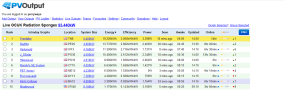I worked out my per string thingy in a sort of hacked together way but I think the maths checks out.
My inverter stores data at 5 min intervals for per string W values.
My logic is that for a given day. The total output generation (yesterday 10.3 kWh) is abstracted from the sum of the W generation per string, as a portion of it's sum.
So I took the sums per string, W facing string was somewhere around 40K, W facing string was somewhere around 80K yesterday. Combined around 120K.
Therefore my S facing string was responsible for (80K / 120K) = 66.6666r % of my 10.3 kWh yesterday or around 6.87 kWh. W facing string the remainder, 33.3333r % or 3.43 kWh.
Back in my best day so far (September 21st) this was more like 60% S facing and 40% W facing, so will be interesting to see how this figure changes over the year.
Interesting side quest: Peak generation on that best day was 1.9kW against the 2.2kW of panels on S string, and 1.6kW against the 2.6kW of panels of W string. I'll keep an eye on this because in ideal conditions both should be close to the limit. It's not impossible for 1 or more of the W facing panels to not be wired up properly or working, hard to validate with a string.




